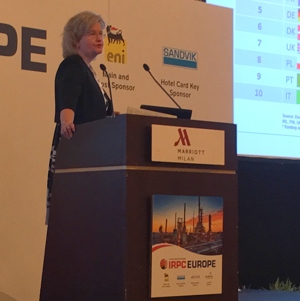IRPC Europe: What is the state of Europe’s chemical industry?
Dorothee Arns, Executive Director, Petrochemicals Europe, European Chemical Industry Council (CEFIC), presented the keynote address at Hydrocarbon Processing’s International Refining and Petrochemical Conference (IRPC) Europe. Ms. Arns’ presentation “Petrochemicals: How macroeconomic factors shape the industry,” provided a detailed overview of the current state of the European petrochemical industry, along with challenges that exist for the European chemical markets’ future competitiveness.
According to CEFIC, global chemical sales are expected to increase from €3.4
The EU petrochemical industry—which makes up nearly 26% of EU chemical sales—is comprised of more than 50 steam crackers, employs more than 300,000 direct jobs and provides more than €155 B to the overall European economy. Although the petrochemical industry is a crucial piece of the European economy, it is very energy and capital intensive. More than 80% of production costs are related to feedstock and energy, and capital cost for the construction of a new steam cracker can run more than €1.5 B. Unfortunately, new ethylene capacity investments are being made in every region except the EU.
Although new ethylene capacity is not being constructed in Europe, the region’s chemical industry has optimized its operations to increase production while reducing greenhouse gas (GHG) emissions. “From 1990–2014,” said explained Mr. Arns, “the eco-footprint of Europe’s chemical industry has substantially improved…increasing production by approximately 80% while reducing GHG emissions by 60%.” According to the European Environment Agency (EEA) and CEFIC analysis, total GHG emissions in the EU chemical industry has decreased from 325
To summarize her presentation, Ms. Arns listed the pros and cons for European competitiveness. Although the cons included a low “new consumers” population growth in the EU, high energy
IRPC Europe continues through Thursday in Milan, Italy.







Comments